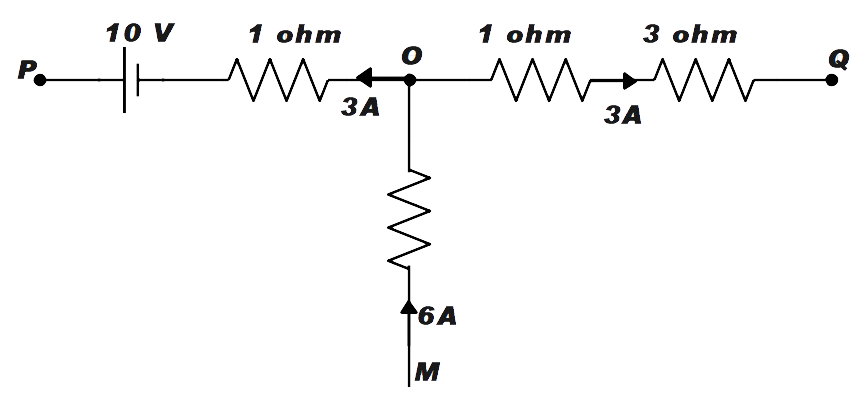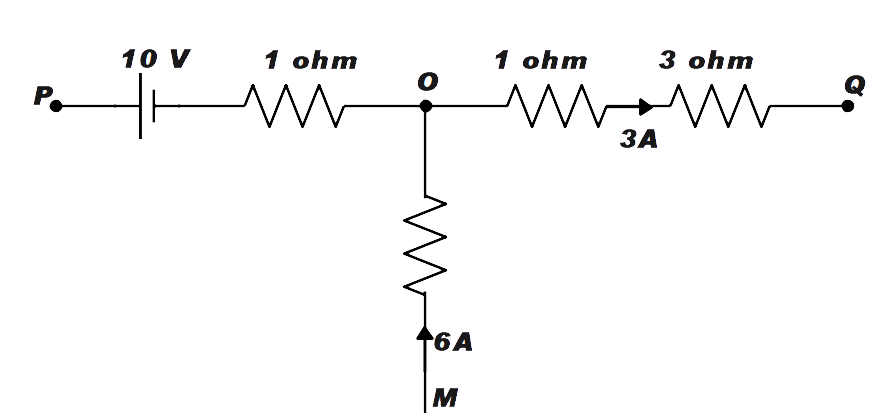Answer
385.8k+ views
Hint: In this question we have been asked to calculate the potential difference between the two points of the given part of circuit. To solve this question, we shall calculate the current flowing through each arm and later using Ohm's law, we shall calculate the potential across the given points. While solving we must remember that the potential difference in the direction of current is taken as negative.
Complete answer:
In the given diagram, the current in the arm PO is not given. Therefore, we shall calculate the current in the arm PO.
Now, in the given figure, we can see that the current in arm OM is 6 Amperes. This current is then split between arm PO and OQ. The current flowing in arm OQ is 3 Amperes. Therefore, the remaining current will flow in the arm OP. The magnitude of the current shall be 3 Amperes and the direction as shown in the figure below.

Now, using Kirchhoff’s rule
We can say that,
\[{{V}_{P}}-10V+3\times 1-3\times 1-3\times 3={{V}_{Q}}\]
Therefore, on solving
We get,
\[{{V}_{P}}-{{V}_{Q}}=10+3-3+9\]
Therefore,
\[{{V}_{P}}-{{V}_{Q}}=19V\]
Therefore, the potential across points PQ is 19 Volts.
Note:
The Ohm’s Law states that the current in a circuit is directly proportional to the voltage applied and inversely proportional to the total resistance in the circuit. Potential difference or voltage can be defined as the amount of work needed per unit charge to move that charge between two given points. The unit of potential difference was named after Alessandro Volta.
Complete answer:
In the given diagram, the current in the arm PO is not given. Therefore, we shall calculate the current in the arm PO.
Now, in the given figure, we can see that the current in arm OM is 6 Amperes. This current is then split between arm PO and OQ. The current flowing in arm OQ is 3 Amperes. Therefore, the remaining current will flow in the arm OP. The magnitude of the current shall be 3 Amperes and the direction as shown in the figure below.

Now, using Kirchhoff’s rule
We can say that,
\[{{V}_{P}}-10V+3\times 1-3\times 1-3\times 3={{V}_{Q}}\]
Therefore, on solving
We get,
\[{{V}_{P}}-{{V}_{Q}}=10+3-3+9\]
Therefore,
\[{{V}_{P}}-{{V}_{Q}}=19V\]
Therefore, the potential across points PQ is 19 Volts.
Note:
The Ohm’s Law states that the current in a circuit is directly proportional to the voltage applied and inversely proportional to the total resistance in the circuit. Potential difference or voltage can be defined as the amount of work needed per unit charge to move that charge between two given points. The unit of potential difference was named after Alessandro Volta.
Recently Updated Pages
How many sigma and pi bonds are present in HCequiv class 11 chemistry CBSE

Why Are Noble Gases NonReactive class 11 chemistry CBSE

Let X and Y be the sets of all positive divisors of class 11 maths CBSE

Let x and y be 2 real numbers which satisfy the equations class 11 maths CBSE

Let x 4log 2sqrt 9k 1 + 7 and y dfrac132log 2sqrt5 class 11 maths CBSE

Let x22ax+b20 and x22bx+a20 be two equations Then the class 11 maths CBSE

Trending doubts
Fill the blanks with the suitable prepositions 1 The class 9 english CBSE

At which age domestication of animals started A Neolithic class 11 social science CBSE

Which are the Top 10 Largest Countries of the World?

Give 10 examples for herbs , shrubs , climbers , creepers

Difference between Prokaryotic cell and Eukaryotic class 11 biology CBSE

Difference Between Plant Cell and Animal Cell

Write a letter to the principal requesting him to grant class 10 english CBSE

Change the following sentences into negative and interrogative class 10 english CBSE

Fill in the blanks A 1 lakh ten thousand B 1 million class 9 maths CBSE




